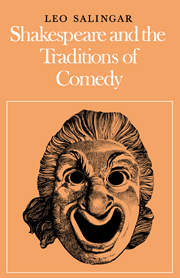3 - ‘Errors’ and deceit in classical comedy
Published online by Cambridge University Press: 04 December 2009
Summary
Comedy aims at representing men as worse…than in actual life.
Aristotle, PoeticsC'est une étrange entreprise que celle de faire rire les honnêtes gens.
La Critique de l'Ecole des FemmesIn spite of Shakespeare's attachment to medieval stage traditions, the classical revival affected his comedies decisively. No doubt he was not unduly attentive to the imitative rules of ‘art’ instilled by scholars and schoolmasters; but this is far from saying that he met them with indifference. Art, as the humanists expounded it, largely with Terence and Plautus in mind, stood for an approach to dramatic structure which was foreign to the medieval theatre and in that sense new: not the staging of impressive moments in a loose chronological sequence, ‘the natural order’ as it could be called, but ‘the artificial order’ of a continuous plot unfolding causal connexions between its incidents as it advances. And this involves a continuous interaction between character and situation and a constant awareness of each of the characters as a separate and consistent personage, whose speeches may forward the general action, but may also invite contrast with the rest of what the audience knows or believes about it – in other words, a constant inclination towards dramatic irony. A modern playwright can take for granted that his audience will notice a logical progression in his plot and will be ready to receive an actor's speeches ironically; indeed, he is almost obliged to start from these assumptions for the sake of dramatic perspective. But they are not the natural, invariable concomitants of every tradition of play-acting, any more than visual perspective is an invariable factor in painting.
- Type
- Chapter
- Information
- Shakespeare and the Traditions of Comedy , pp. 76 - 128Publisher: Cambridge University PressPrint publication year: 1974
- 2
- Cited by



